Analysis of LightGlue Matching for Robust TIN-Based UAV Image Mosaicking
Highlights
- SIFT + LightGlue outperforms traditional methods in terms of the number and spatial distribution of tiepoints/triplets in UAV images.
- SIFT + LightGlue maintains reprojection accuracy while achieving greater robustness of TIN mosaics.
- SIFT + LightGlue enables fast TIN-based mosaicking even in low-texture regions, producing continuous triangulations with fewer voids.
- Adopting SIFT + LightGlue reduces or removes TIN post-processing (e.g., pseudo-tiepoints), enabling faster, more reliable mosaics.
Abstract
1. Introduction
2. Related Work
2.1. Traditional Tiepoint Extraction Method
2.2. LightGlue-Based Tiepoint Extraction Method
3. Materials
4. Method
4.1. Tiepoint Extraction
4.2. Bundle Adjustment
4.3. TIN-Based Image Mosaicking
4.4. Experimental Setup and Parameter Configuration
5. Results
5.1. Tiepoint Extraction Result
5.2. Bundle Adjustment Result
5.3. Mosaic Results
6. Discussion
7. Conclusions
Author Contributions
Funding
Data Availability Statement
Conflicts of Interest
References
- Xing, C.; Wang, J.; Xu, Y. A method for building a mosaic with UAV images. Int. J. Inf. Eng. Electron. Bus. 2010, 2, 9–15. [Google Scholar] [CrossRef]
- Turner, D.; Lucieer, A.; Watson, C. An automated technique for generating georectified mosaics from ultra-high resolution unmanned aerial vehicle (UAV) imagery, based on structure from motion (SfM) point clouds. Remote Sens. 2012, 4, 1392–1410. [Google Scholar] [CrossRef]
- Zhao, J.; Zhang, X.; Gao, C.; Qiu, X.; Tian, Y.; Zhu, Y.; Cao, W. Rapid mosaicking of unmanned aerial vehicle (UAV) images for crop growth monitoring using the SIFT algorithm. Remote Sens. 2019, 11, 1226. [Google Scholar] [CrossRef]
- Yoon, S.-J.; Kim, T. Seamline optimization based on triangulated irregular network of tiepoints for fast UAV image mosaicking. Remote Sens. 2024, 16, 1738. [Google Scholar] [CrossRef]
- Yoon, S.-J.; Kim, T. Fast UAV image mosaicking by a triangulated irregular network of bucketed tiepoints. Remote Sens. 2023, 15, 5782. [Google Scholar] [CrossRef]
- McGlone, J.C. Manual of Photogrammetry; American Society for Photogrammetry and Remote Sensing: Bethesda, MD, USA, 2013. [Google Scholar]
- Wu, T.; Hung, I.-K.; Xu, H.; Yang, L.; Wang, Y.; Fang, L.; Lou, X. An Optimized SIFT-OCT Algorithm for Stitching Aerial Images of a Loblolly Pine Plantation. Forests 2022, 13, 1475. [Google Scholar] [CrossRef]
- Lindenberger, P.; Sarlin, P.-E.; Pollefeys, M. Lightglue: Local feature matching at light speed. In Proceedings of the IEEE/CVF International Conference on Computer Vision, Paris, France, 2–6 October 2023; pp. 17627–17638. [Google Scholar]
- Bay, H.; Ess, A.; Tuytelaars, T.; Van Gool, L. Speeded-up robust features (SURF). Comput. Vis. Image Underst. 2008, 110, 346–359. [Google Scholar] [CrossRef]
- Rublee, E.; Rabaud, V.; Konolige, K.; Bradski, G. ORB: An efficient alternative to SIFT or SURF. In Proceedings of the 2011 International Conference on Computer Vision, Barcelona, Spain, 6–13 November 2011; pp. 2564–2571. [Google Scholar]
- Lowe, D.G. Distinctive image features from scale-invariant keypoints. Int. J. Comput. Vis. 2004, 60, 91–110. [Google Scholar] [CrossRef]
- Muja, M.; Lowe, D.G. Fast approximate nearest neighbors with automatic algorithm configuration. VISAPP 2009, 2, 2. [Google Scholar]
- Mikolajczyk, K.; Schmid, C. A performance evaluation of local descriptors. IEEE Trans. Pattern Anal. Mach. Intell. 2005, 27, 1615–1630. [Google Scholar] [CrossRef] [PubMed]
- Lingua, A.; Marenchino, D.; Nex, F. Performance analysis of the SIFT operator for automatic feature extraction and matching in photogrammetric applications. Sensors 2009, 9, 3745–3766. [Google Scholar] [CrossRef] [PubMed]
- Sur, F.; Noury, N.; Berger, M.-O. Image Point Correspondences and Repeated Patterns; INRIA: Le Chesnay-Rocquencourt, France, 2011. [Google Scholar]
- Zhang, W.; Li, X.; Yu, J.; Kumar, M.; Mao, Y. Remote sensing image mosaic technology based on SURF algorithm in agriculture. EURASIP J. Image Video Process. 2018, 2018, 85. [Google Scholar] [CrossRef]
- Sarlin, P.-E.; DeTone, D.; Malisiewicz, T.; Rabinovich, A. Superglue: Learning feature matching with graph neural networks. In Proceedings of the IEEE/CVF Conference on Computer Vision and Pattern Recognition, Seattle, WA, USA, 13–19 June 2020; pp. 4938–4947. [Google Scholar]
- DeTone, D.; Malisiewicz, T.; Rabinovich, A. Superpoint: Self-supervised interest point detection and description. In Proceedings of the IEEE Conference on Computer Vision and Pattern Recognition Workshops, Salt Lake City, UT, USA, 18–22 June 2018; pp. 224–236. [Google Scholar]
- Mo, Y.; Kang, X.; Duan, P.; Li, S. A robust UAV hyperspectral image stitching method based on deep feature matching. IEEE Trans. Geosci. Remote Sens. 2021, 60, 1–14. [Google Scholar] [CrossRef]
- Song, S.; Morelli, L.; Wu, X.; Qin, R.; Albanwan, H.; Remondino, F. Deep Learning Meets Satellite Images–An Evaluation on Handcrafted and Learning-Based Features for Multi-date Satellite Stereo Images. In Proceedings of the European Conference on Computer Vision, Milan, Italy, 29 September–4 October 2024; pp. 50–67. [Google Scholar]
- Morelli, L.; Ioli, F.; Maiwald, F.; Mazzacca, G.; Menna, F.; Remondino, F. Deep-image-matching: A toolbox for multiview image matching of complex scenarios. Int. Arch. Photogramm. Remote Sens. Spat. Inf. Sci. 2024, 48, 309–316. [Google Scholar] [CrossRef]
- Feng, Y.; Zhang, F.; Li, X.; Xiao, X.; Wang, L.; Xiang, X. Research on Image Stitching Based on an Improved LightGlue Algorithm. Processes 2025, 13, 1687. [Google Scholar] [CrossRef]
- Vultaggio, F.; Fanta-Jende, P.; Schörghuber, M.; Kern, A.; Gerke, M. Investigating Visual Localization Using Geospatial Meshes. Int. Arch. Photogramm. Remote Sens. Spat. Inf. Sci. 2024, 48, 447–454. [Google Scholar] [CrossRef]
- Mousavi, V.; Varshosaz, M.; Remondino, F. Evaluating tie points distribution, multiplicity and number on the accuracy of uav photogrammetry blocks. Int. Arch. Photogramm. Remote Sens. Spat. Inf. Sci. 2021, 43, 39–46. [Google Scholar] [CrossRef]
- Bergström, P.; Edlund, O. Robust registration of point sets using iteratively reweighted least squares. Comput. Optim. Appl. 2014, 58, 543–561. [Google Scholar] [CrossRef]
- Luo, Q.; Zhang, J.; Xie, Y.; Huang, X.; Han, T. Comparative Analysis of Advanced Feature Matching Algorithms in Challenging High Spatial Resolution Optical Satellite Stereo Scenarios. In Proceedings of the IGARSS 2024-2024 IEEE International Geoscience and Remote Sensing Symposium, Athens, Greece, 7–12 July 2024; pp. 2645–2649. [Google Scholar]
- Cueto Zumaya, C.R.; Catalano, I.; Queralta, J.P. Building Better Models: Benchmarking Feature Extraction and Matching for Structure from Motion at Construction Sites. Remote Sens. 2024, 16, 2974. [Google Scholar] [CrossRef]
- Liu, C.; Song, K.; Wang, W.; Zhang, W.; Yang, Y.; Sun, J.; Wang, L. A vision-inertial interaction-based autonomous UAV positioning algorithm. Meas. Sci. Technol. 2025, 36, 026304. [Google Scholar] [CrossRef]
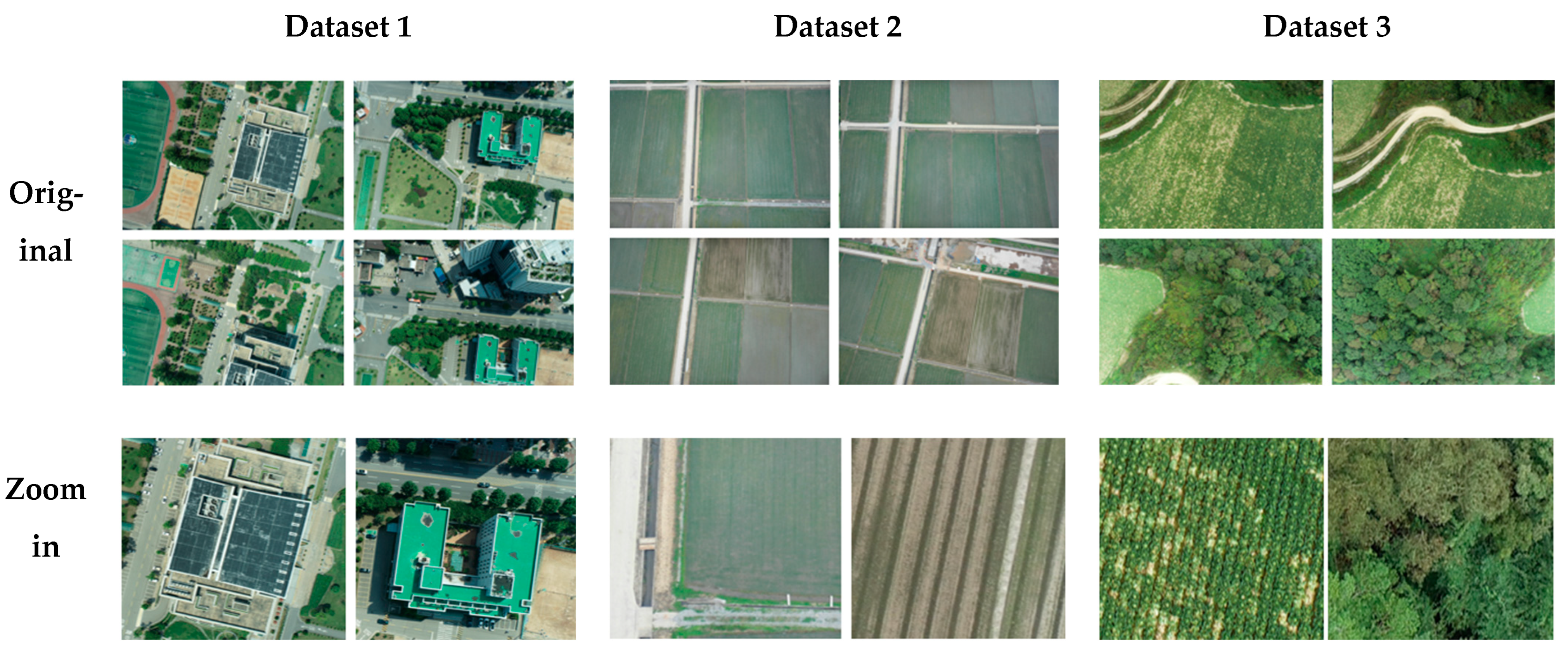
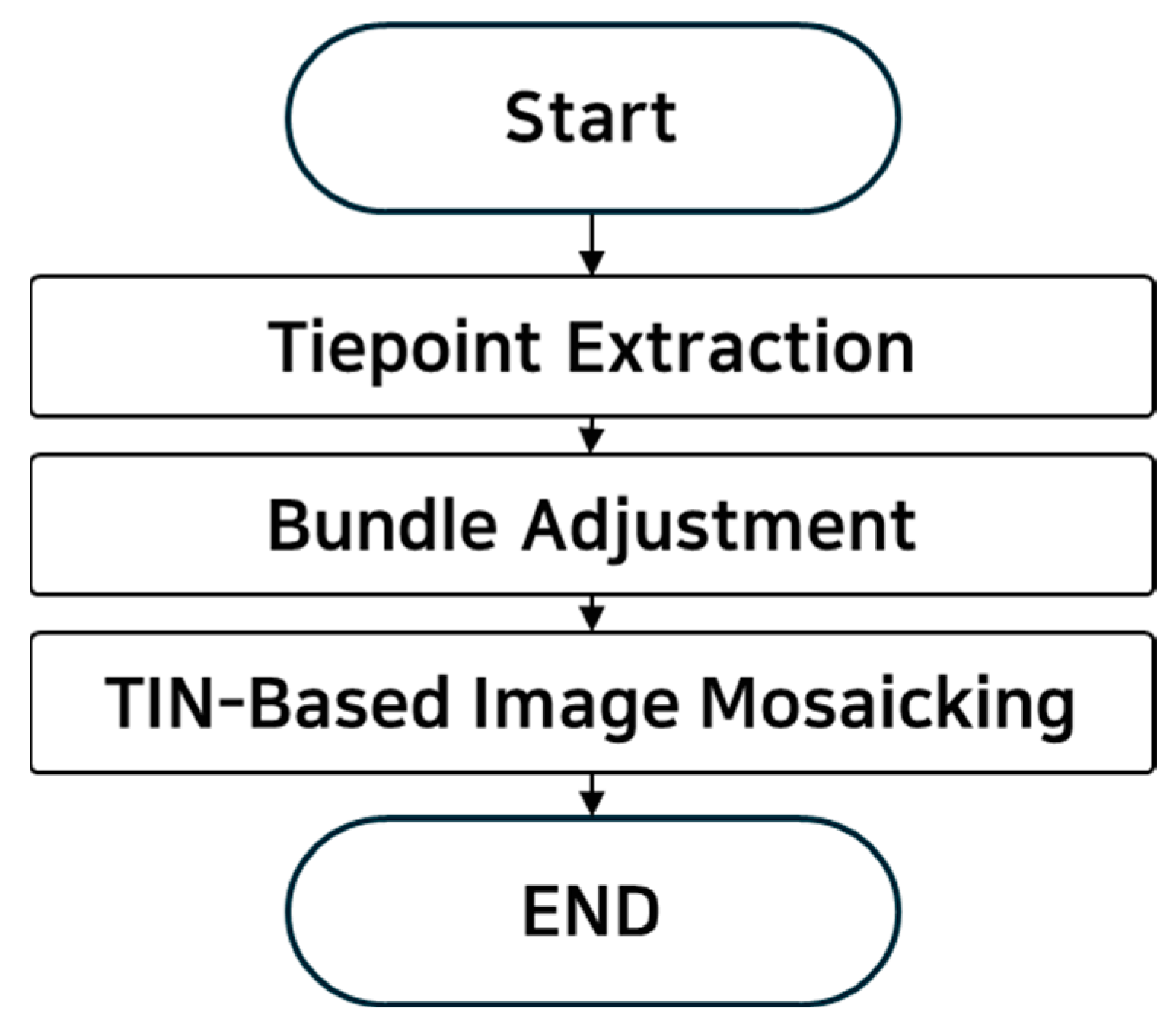
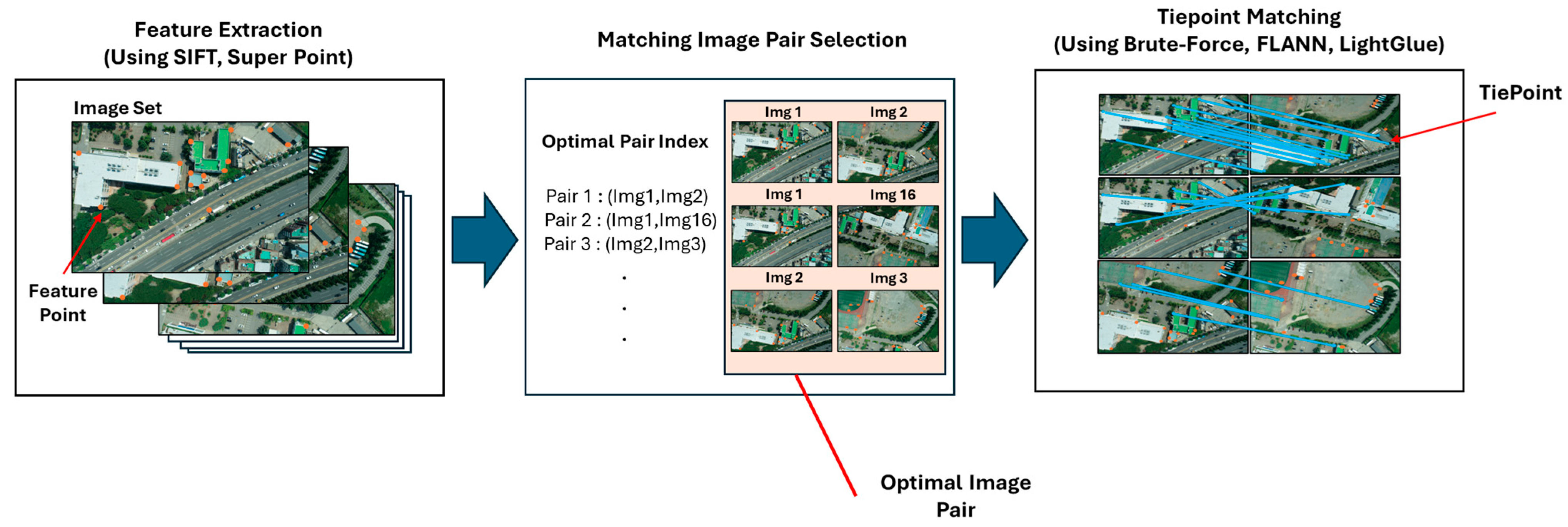
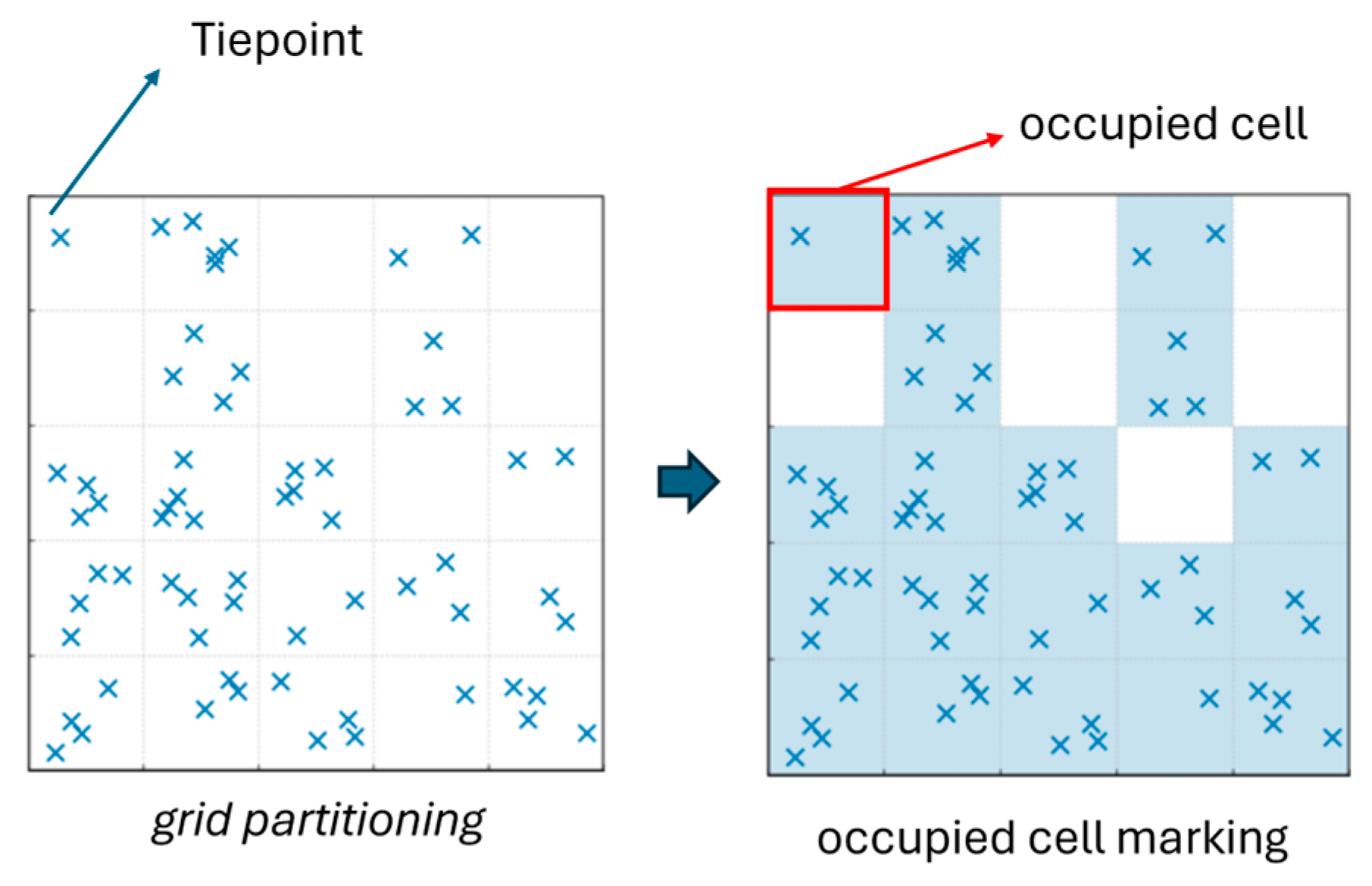
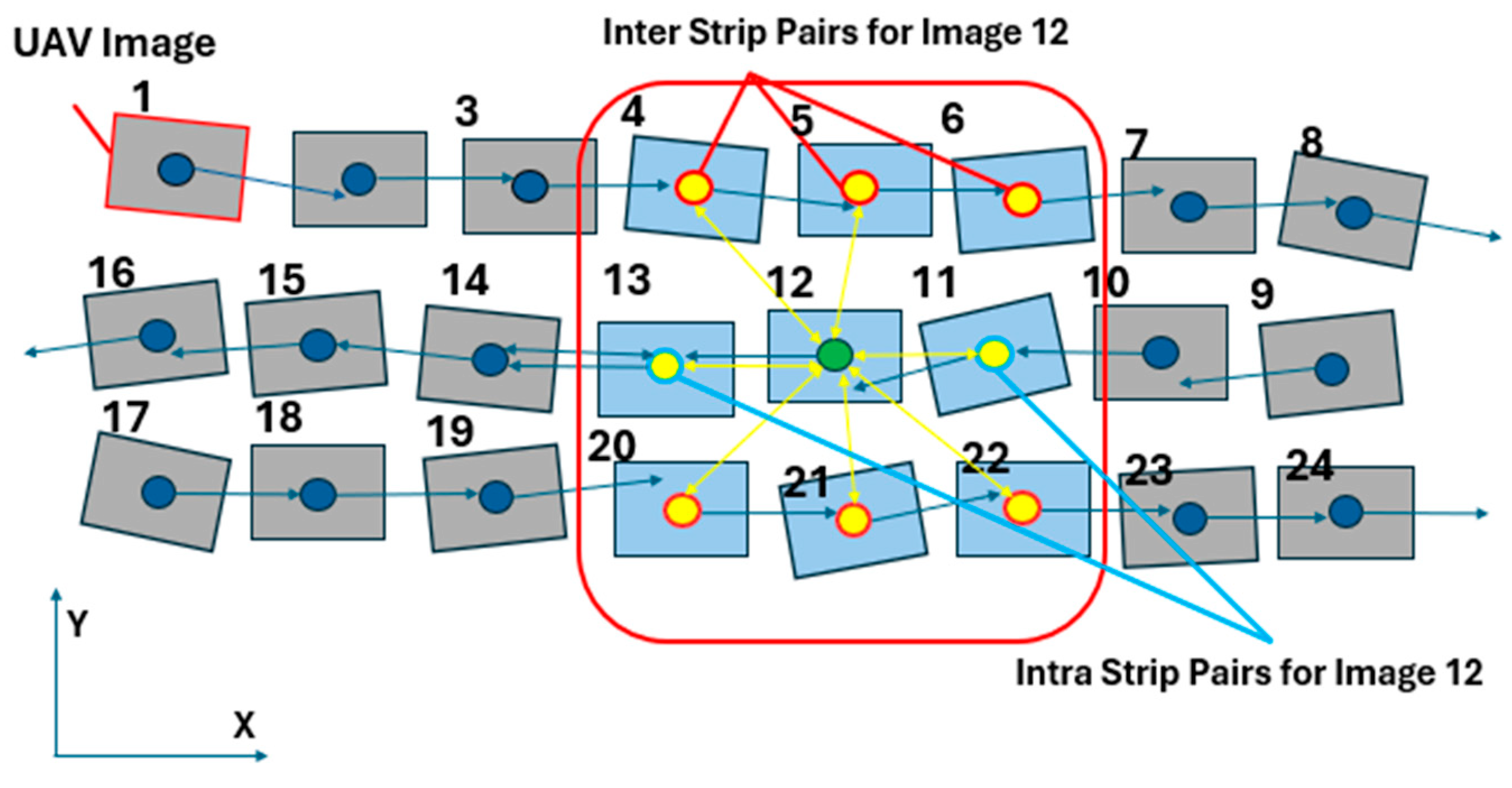

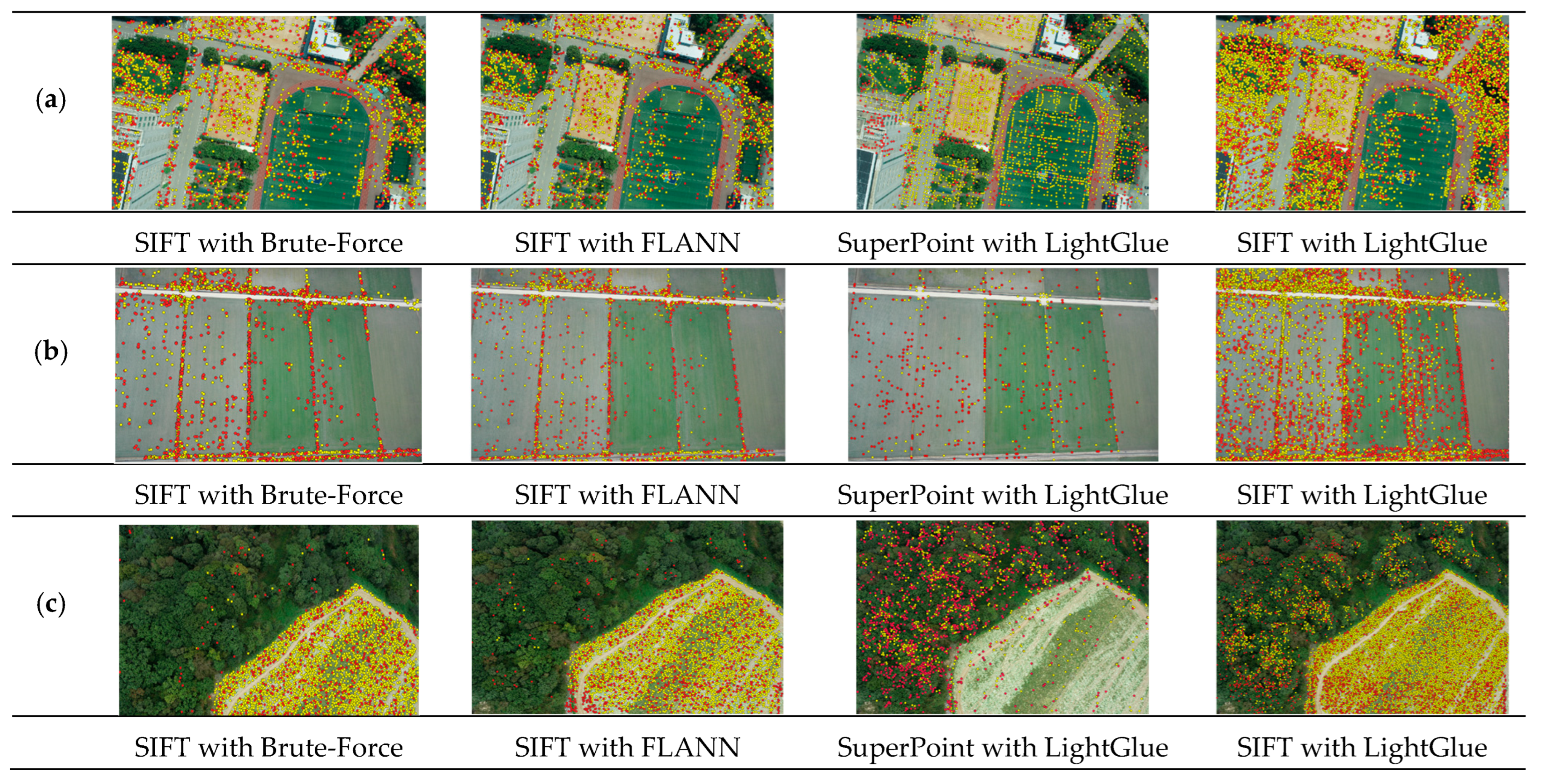
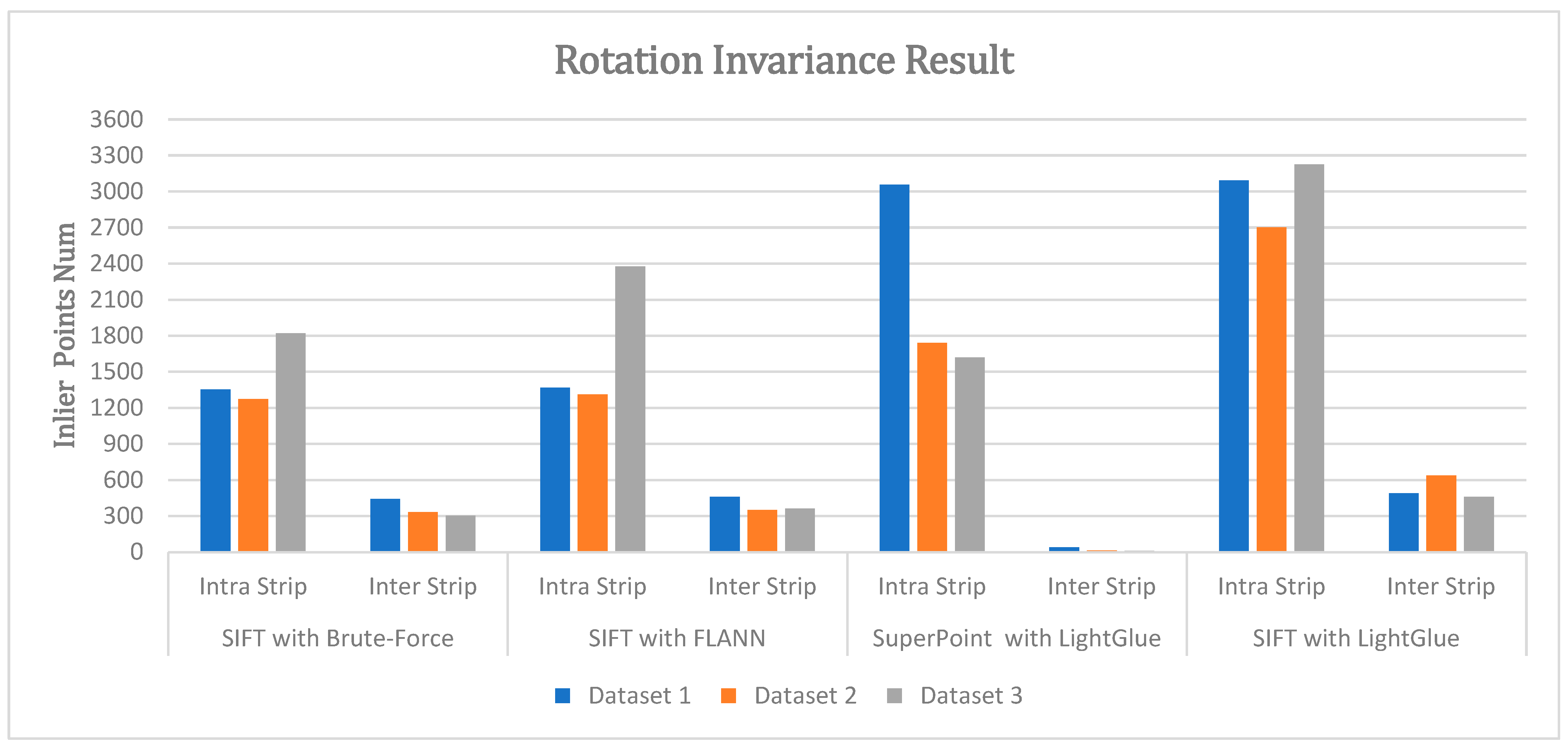


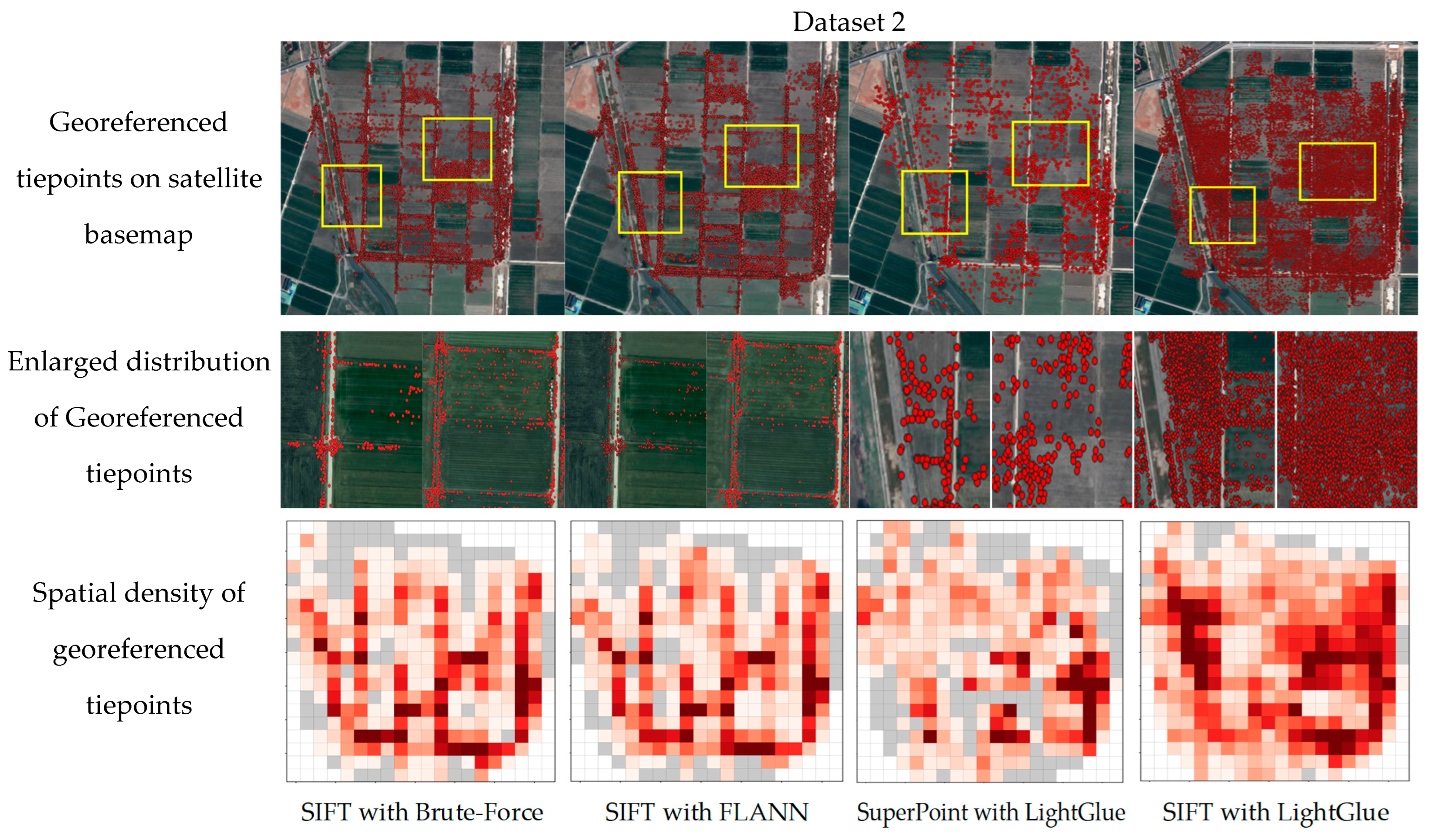



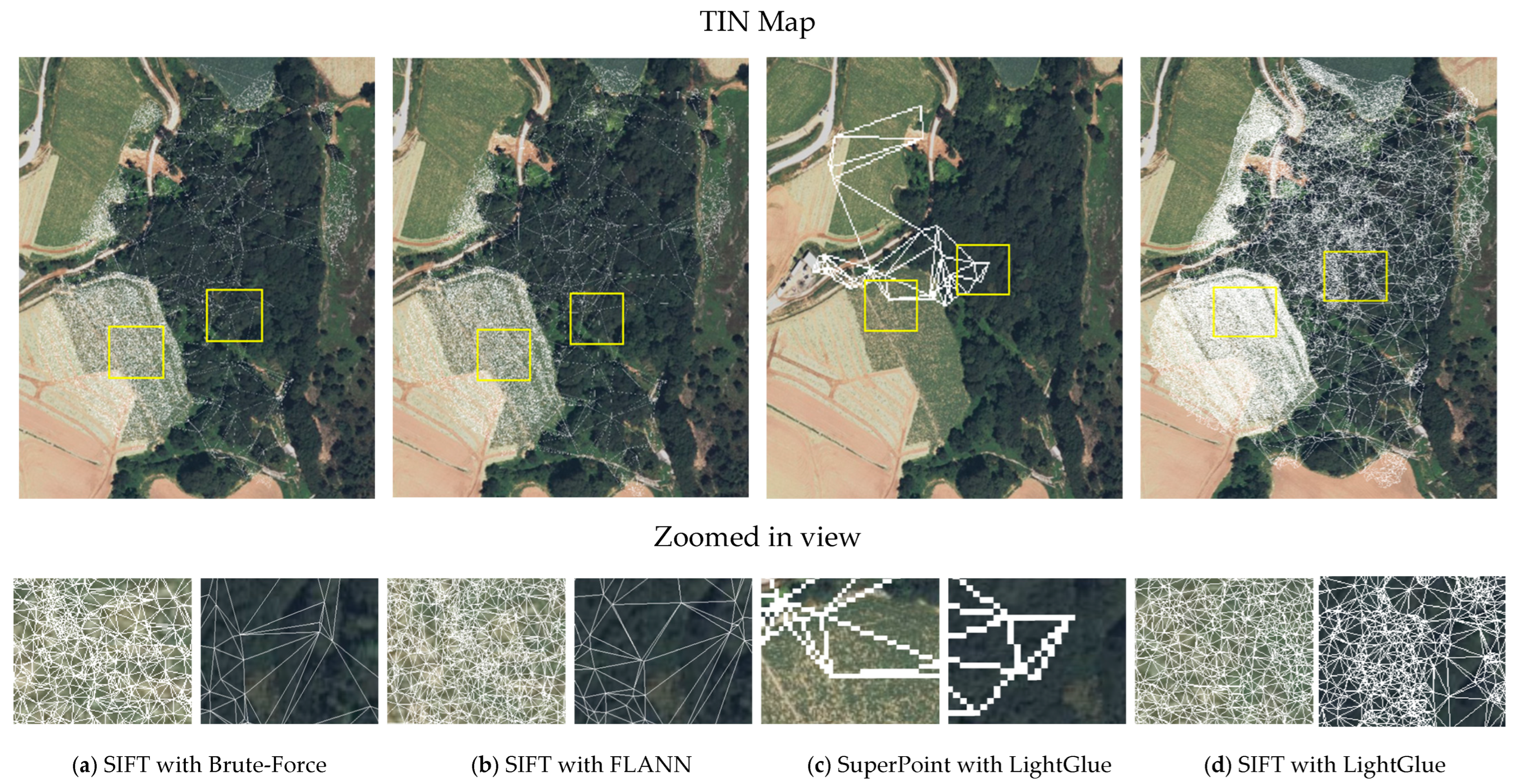

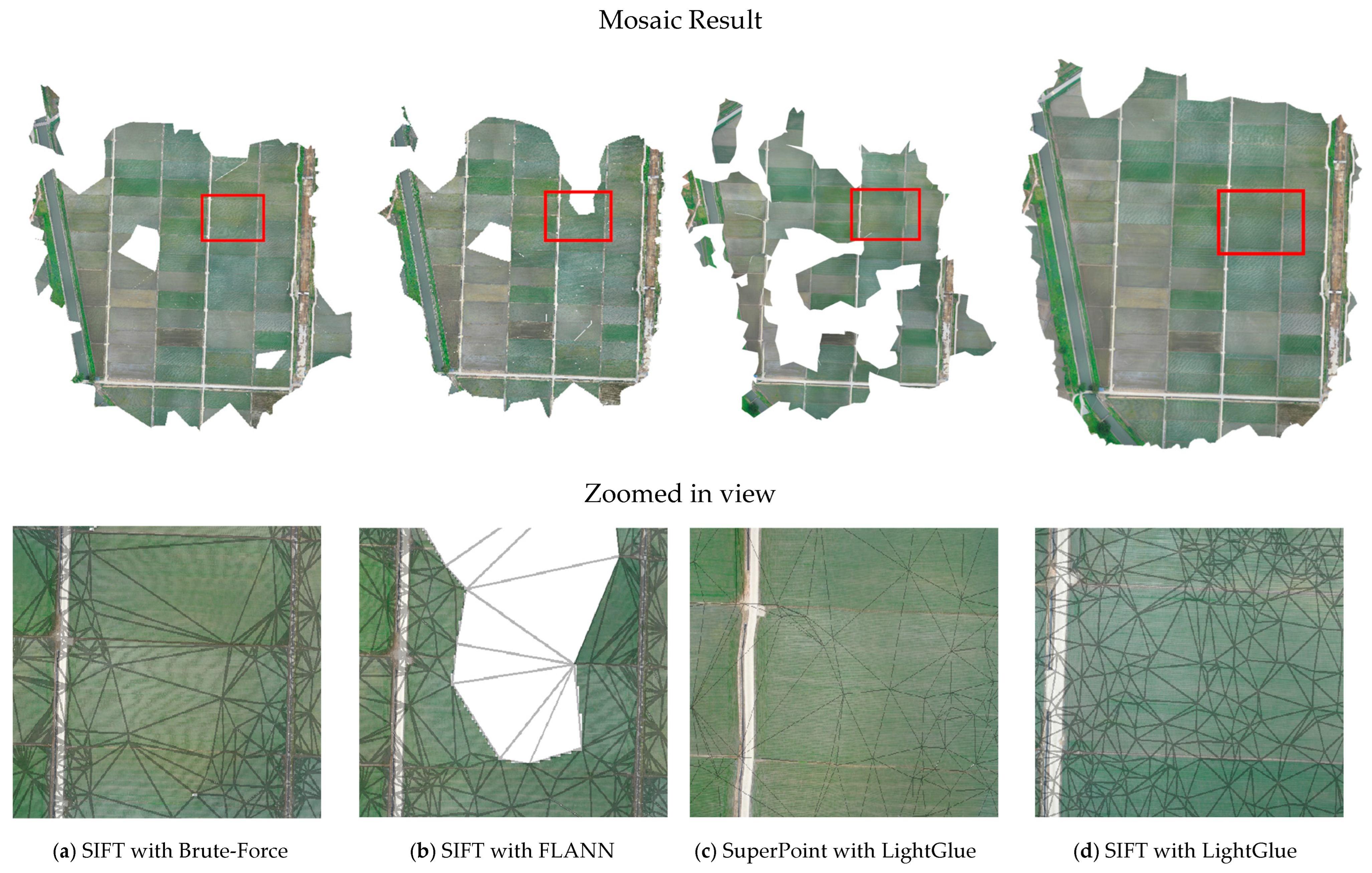

| Dataset 1 | Dataset 2 | Dataset 3 | |
|---|---|---|---|
| Platform | Phantom4 RTK | eBee | Phantom4 RTK |
| Manufacturer | DJI | senseFly | DJI |
| Flight Type | Rotary Wing | Fixed Wing | Rotary Wing |
| Image Type | Developed Area | Agricultural Area | Mountainous Area |
| Image Number | 51 | 125 | 105 |
| Image Size | 5472 × 3648 | 5472 × 3648 | 5472 × 3648 |
| Overlap (End/Side) | 80%/70% | 85%/75% | 80%/70% |
| GSD | 0.0462 m | 0.0375 m | 0.0452 m |
| Case | Feature Detection Algorithm | Feature Matching Algorithm |
|---|---|---|
| 1 | SIFT | Brute-Force |
| 2 | SIFT | FLANN |
| 3 | SuperPoint | LightGlue |
| 4 | SIFT | LightGlue |
| ID | Matching Algorithm | Tiepoint Number | Coverage Ratio (%) | Epipolar Error (px) | ||
|---|---|---|---|---|---|---|
| Total | Triplet | Total | Triplet | |||
| Dataset1 | SIFT with Brute-Force | 51,004 | 20,112 | 84.14 | 73.71 | 0.9721 |
| SIFT with FLANN | 51,175 | 20,154 | 84.71 | 73.83 | 0.9724 | |
| SuperPoint with LightGlue | 85,894 | 30,967 | 90.72 | 80.97 | 1.6754 | |
| SIFT with LightGlue | 93,940 | 46,115 | 90.97 | 81.17 | 1.0578 | |
| Dataset2 | SIFT with Brute-Force | 110,007 | 35,157 | 64.09 | 51.61 | 0.9713 |
| SIFT with FLANN | 110,562 | 35,458 | 65.06 | 52.48 | 0.9715 | |
| SuperPoint with LightGlue | 92,073 | 28,120 | 65.09 | 43.02 | 1.5420 | |
| SIFT with LightGlue | 186,335 | 72,376 | 82.51 | 71.94 | 1.0658 | |
| Dataset3 | SIFT with Brute-Force | 97,846 | 35,207 | 65.68 | 50.46 | 0.9493 |
| SIFT with FLANN | 106,406 | 38,458 | 67.61 | 53.02 | 0.9558 | |
| SuperPoint with LightGlue | 86,861 | 12,982 | 73.20 | 59.44 | 1.4771 | |
| SIFT with LightGlue | 208,251 | 96,845 | 84.80 | 75.58 | 1.1212 | |
| Matching Algorithm | Number of Georeferenced Tiepoints | Coverage Ratio of Georeferenced Tiepoints | Reprojection Error (px) | Y–Parallax (px) | |
|---|---|---|---|---|---|
| DataSet1 | SIFT with Brute-Force | 12,699 | 81.6% | 1.6171 | 1.1247 |
| SIFT with FLANN | 12,831 | 80.9% | 1.6017 | 1.1151 | |
| SuperPoint with LightGlue | 423 | 15.1% | 2.4933 | 2.5514 | |
| SIFT with LightGlue | 21,355 | 84.5% | 1.6743 | 1.1699 | |
| DataSet2 | SIFT with Brute-Force | 14,763 | 71.7% | 1.2913 | 1.3056 |
| SIFT with FLANN | 15,023 | 72.6% | 1.2418 | 1.2711 | |
| SuperPoint with LightGlue | 3001 | 68.2% | 3.7883 | 3.5150 | |
| SIFT with LightGlue | 38,914 | 80.3% | 1.3022 | 1.3870 | |
| DataSet3 | SIFT with Brute-Force | 16,517 | 60.3% | 2.0917 | 1.3417 |
| SIFT with FLANN | 16,801 | 55.6% | 2.0876 | 1.3658 | |
| SuperPoint with LightGlue | 96 | 4.6% | 3.8427 | 3.4174 | |
| SIFT with LightGlue | 34,792 | 81.8% | 1.8929 | 1.2948 |
| Matching Algorithm | Number of TIN Facets | Processing Time (Seconds) | |
|---|---|---|---|
| DataSet1 | SIFT with Brute-Force | 20,623 | 401 |
| SIFT with FLANN | 21,112 | 396 | |
| SuperPoint with LightGlue | 710 | 227 | |
| SIFT with LightGlue | 35,375 | 394 | |
| DataSet2 | SIFT with Brute-Force | 28,670 | 764 |
| SIFT with FLANN | 29,912 | 748 | |
| SuperPoint with LightGlue | 5604 | 425 | |
| SIFT with LightGlue | 77,063 | 803 | |
| DataSet3 | SIFT with Brute-Force | 28,073 | 511 |
| SIFT with FLANN | 27,810 | 491 | |
| SuperPoint with LightGlue | 181 | 283 | |
| SIFT with LightGlue | 69,557 | 541 |
Disclaimer/Publisher’s Note: The statements, opinions and data contained in all publications are solely those of the individual author(s) and contributor(s) and not of MDPI and/or the editor(s). MDPI and/or the editor(s) disclaim responsibility for any injury to people or property resulting from any ideas, methods, instructions or products referred to in the content. |
© 2025 by the authors. Licensee MDPI, Basel, Switzerland. This article is an open access article distributed under the terms and conditions of the Creative Commons Attribution (CC BY) license (https://creativecommons.org/licenses/by/4.0/).
Share and Cite
Kim, S.; Ban, S.; Kim, H.; Kim, T. Analysis of LightGlue Matching for Robust TIN-Based UAV Image Mosaicking. Remote Sens. 2025, 17, 3767. https://doi.org/10.3390/rs17223767
Kim S, Ban S, Kim H, Kim T. Analysis of LightGlue Matching for Robust TIN-Based UAV Image Mosaicking. Remote Sensing. 2025; 17(22):3767. https://doi.org/10.3390/rs17223767
Chicago/Turabian StyleKim, Sunghyeon, Seunghwan Ban, Hongjin Kim, and Taejung Kim. 2025. "Analysis of LightGlue Matching for Robust TIN-Based UAV Image Mosaicking" Remote Sensing 17, no. 22: 3767. https://doi.org/10.3390/rs17223767
APA StyleKim, S., Ban, S., Kim, H., & Kim, T. (2025). Analysis of LightGlue Matching for Robust TIN-Based UAV Image Mosaicking. Remote Sensing, 17(22), 3767. https://doi.org/10.3390/rs17223767







